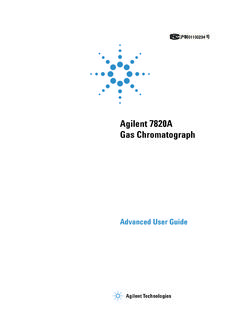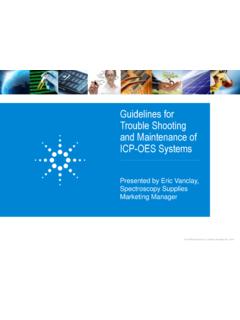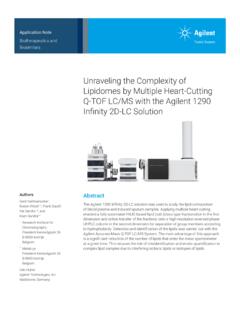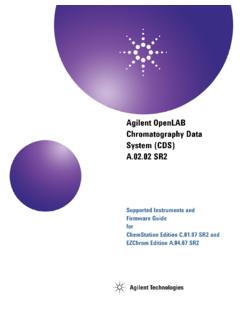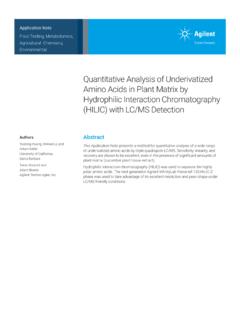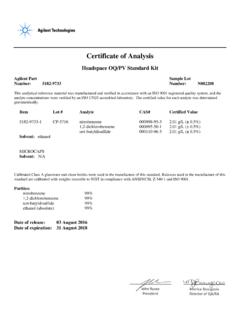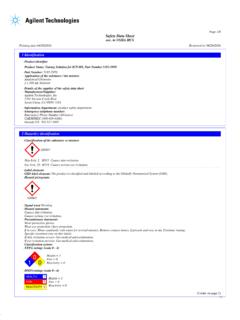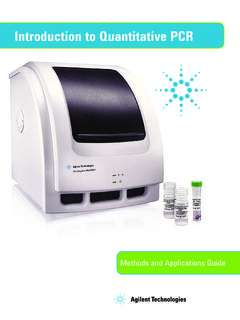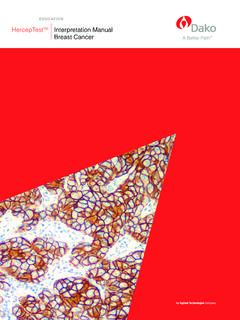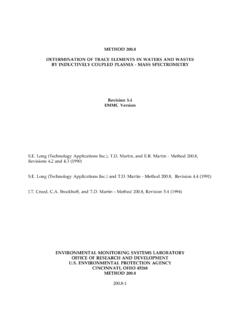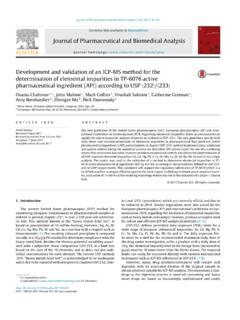Transcription of Agilent’s ICP-MS solution for USP <232>/<233> & ICH Q3D ...
1 White PaperElemental Impurity Analysis Requirements Worldwide, regulatory authorities are responsible for ensuring that pharmaceutical products are both effective and safe. Potentially toxic and harmful contaminants including elemental impurities must be identified, and limits defined for the maximum levels that a patient should be exposed to. In February 2017, new procedures for the analysis of elemental (inorganic) impurities in pharmaceutical products and ingredients were finalized. Existing wet chemical and colorimetric tests, such as European Pharmacopoeia Heavy Metals chapter and United States Pharmacopeial Convention (USP) General Chapter <231>, have been replaced with instrumental methods. These methods provide specific, quantitative determination of individual elemental impurities in drug products and <232>/<233> and ICH Q3D Elemental Impurities Analysis:The Agilent ICP-MS Solution2 The USP, in parallel with the International Council for Harmonisation of Technical Requirements for Pharmaceuticals for Human Use (ICH), has revised the standards for measuring inorganic impurities in pharmaceuticals and their ingredients.
2 The updated USP General Chapters USP<232> (Elemental Impurities Limits)(1) and <233> (Elemental Impurities Procedures)(2) were implemented in January 2018. The equivalent ICH method is defined in the Guideline for Elemental Impurities (Q3D)(3). ICH-Q3D has been in effect since June 2016 for new marketing authorization applications and has applied to previously authorized medicinal products since December latest ICH Q3D and USP<232> chapters include catalyst elements, and other inorganic contaminants that may enter a drug product. Such contaminants can come from raw materials, the manufacturing process, the environment, packaging, and container closure systems (CCS). The maximum exposure limits are defined according to each impurity's toxicity and route of administration, rather than method capability, as was the case for the old colorimetric sulfide precipitate test in USP<231>.
3 USP<233> recommends the use of modern instrumental techniques (Inductively Coupled Plasma Optical Emission Spectroscopy (ICP-OES) or ICP-Mass Spectrometry ( ICP-MS )), in place of the colorimetric test used in USP<231>. Alternative procedures may be used, provided they can be demonstrated to meet the performance requirements defined in the chapters. USP <233> also recommends the use of closed vessel sample digestion for solid samples, to ensure the quantitative recovery of all the regulated analytes, including volatile elements such as s equivalent method for analyzing pharmaceutical materials (including traditional Chinese medicines TCM) is defined in the China Pharmacopoeia (ChP) 2020 Edition. This edition, which was approved in April 2020 and came into effect on December 30 2020, also includes ICP-MS as the recommended analytical technique for determining elemental impurities in pharmaceutical Impurity LimitsThe permitted daily exposure (PDE) limits for elemental impurities in drugs intended for oral, parenteral, and inhalational routes of administration, as per the ICH and USP chapters, are shown in Table potential toxicity of an elemental impurity is different depending on the route of administration.
4 Elemental impurities must be considered in a product risk assessment, appropriate for the intended route of administration of the final drug product. The likelihood of the element being naturally present ( elements associated with a mineral-based raw material) or intentionally or unintentionally added ( as a catalyst in chemical reactions, or via contamination from process equipment) must also be considered. The most toxic and ubiquitous Class 1 elements (Cd, Pb, As, and Hg) must be considered in the risk assessment for all drug products. Other elements, such as the Class 3 impurities, may need to be considered only if the drug is intended for parenteral or inhalational administration. The three classes are defined based on the toxicity of the elements and the likelihood of them occurring in drug products intended for each route of General Chapter <232> provides guidance on how a manufacturer should conduct the risk assessment to demonstrate compliance with the regulated limits for any given pharmaceutical product.
5 Options include: Direct analysis of the final drug formulation Measurement of the level of impurities in each of the component materials used in the drug material Review of test data, or A risk assessment provided by a qualified raw material supplier. If a risk assessment is performed, it must follow the guidelines defined in USP<232>, summarized in Table 1. 3 The J-value The maximum level of elemental impurities in finished drug products is expressed as a maximum permitted daily exposure (PDE). This limit considers the concentration of the element present in the drug product, and the maximum recommended daily dose for the medicine. Some materials require digestion or dilution in a solvent before analysis. For these materials, the PDE limit (in g/day) must be converted to a concentration limit (in g/L) as measured in the prepared sample.
6 This conversion takes into account the dilution required to bring the analytes within the analytical range of the instrument and the maximum daily dosage. The Target Concentration value in the prepared sample, referred to as the J-value , defines the maximum permitted concentration limit for the analyte in that sample. The J value is calculated from:J = PDE Total Dilution x Max Daily DoseThe Agilent ICP-MS MassHunter software calculates the J-values for each analyte. This calculation includes the final dosage form of the drug material being analyzed and the dilution factor applied. The calculation is illustrated in Table 2 for the Class 1 elements Cd, Pb, As, and Hg. The calculation uses a maximum dosage of 1 g/day and dilution factors of 250 x ( g in 50 mL) and 1000 x ( g in 100 mL).
7 Typical instrumental detection limits (IDLs) for the Agilent 7850 ICP-MS are also shown, for comparison. Similar or slightly lower limits would be achieved using the Agilent 1. The permitted daily exposure (PDE) limits for elemental impurities in drug products, according to their route of administration. Elements shaded in the table should be considered in product risk assessment. All elements listed should be included in risk assessment if naturally present or if intentionally or unintentionally Class Element Oral PDE ( g/day)Parenteral PDE ( g/day) Inhalational PDE ( g/day) Class 1 Cd - Cadmium 522 Pb - Lead 555 As - Arsenic (inorganic) 15152 Hg - Mercury (inorganic) 3031 Class 2A Co - Cobalt 5053 V - Vanadium 100101 Ni - Nickel 200205 Class 2B Tl - Thallium 888 Au - Gold 1001001 Pd - Palladium 100101 Ir - Iridium 100101 Os - Osmium 100101 Rh - Rhodium 100101 Ru - Ruthenium 100101 Se - Selenium 15080130 Ag - Silver 150107 Pt - Platinum 100101 Class 3 Li - Lithium 55025025 Sb - Antimony 12009020 Ba - Barium 1400700300 Mo - Molybdenum 3000150010 Cu - Copper 300030030 Sn - Tin 600060060 Cr - Chromium 11000110034 Table 2.
8 Example J value calculation and comparative ICP-MS instrument detection limits (IDLs).Element Oral Dose PDE ( g/day*)J-value @ 250x Dil. ( g/L) J-value @ 1000x Dil. ( g/L) Agilent 7850 ICP-MS IDLs ( g/L)Cd ** ** * Values apply to oral dose drugs with a daily dose of 10 g. ** Inorganic formsThe J-value is also used to define the calibration levels and QC concentrations. For example; calibrations must be prepared at concentration levels between and J. Detectability (for Limit procedures) must be demonstrated using a sample spiked at 80% of the J value ( J). Spike recovery tests must also be performed at concentrations ranging from 50 to 150% of the J value ( between and J).The Complete Agilent Workflow solution for Implementing an Elemental Impurities Testing Capability Sample preparation The USP<233> chapter references several methods that can be used for the preparation of samples for analysis by the compendial procedures ICP-MS and ICP-OES.
9 These include: Direct analysis Dilution/solubilization in a suitable aqueous solvent, such as water or dilute acid Dilution/solubilization in a suitable organic solvent, such as 2-butoxyethanol:water (25:75), DMSO, or DGME Indirect solution , preferably using closed-vessel microwave digestion with strong acids Most solid pharmaceutical materials can be digested using closed-vessel microwave digestion in nitric and hydrochloric acid. This procedure provides a sample digest in which all the regulated elements are stabilized in solution , ready for analysis by ICP-MS or ICP-OES, after appropriate dilution. The inclusion of at least HCl is strongly recommended for stabilization of all samples, as it ensures that elements such as Hg remain in solution .
10 Addition of HCl is essential when platinum group elements (PGEs) such as Pt, Pd, and Os are included in the analysis. A higher level of HCl may be required for long-term stability of these elements. Agilent works closely with the leading microwave oven suppliers around the world. These collaborations ensure that pharmaceutical laboratories can select the most appropriate microwave to install, depending on their method requirements and the microwave oven supplier s local support ICP-MS instruments tolerate all common acid and organic solvent matrices (4), as well as other complex matrices, those produced by dissolving solid samples. Most sample types can be measured without requiring high dilution factors (5, 6). Agilent ICP-MS systems have a robust, high temperature (low CeO/Ce) plasma, ensuring good ionization and high sensitivity for all analytes.
